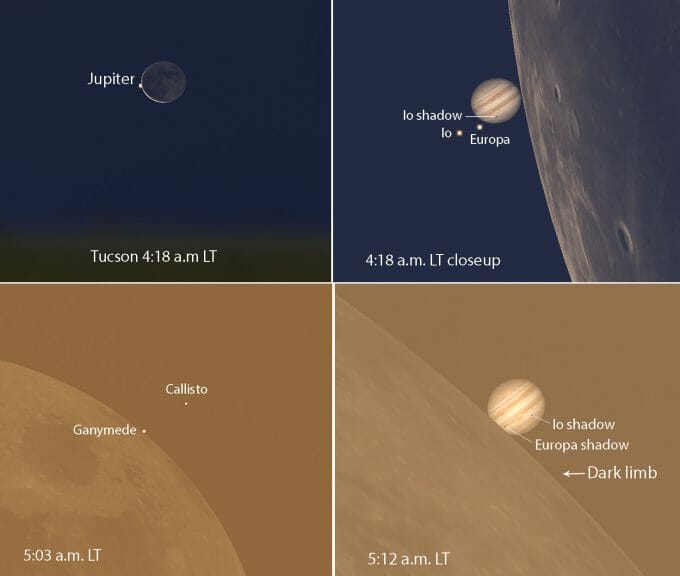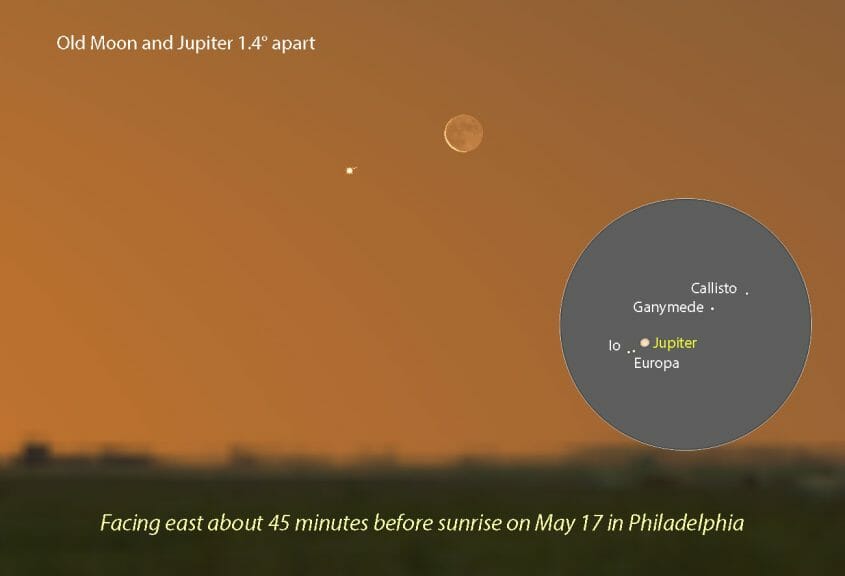Hold on tight, folks, because we’ve got a celestial show in the works that’ll leave you awestruck! Brace yourselves for a mind-boggling event unfolding high above us.
Picture this: a rendezvous between Jupiter and the Moon, set to dazzle the skies on Wednesday morning, May 17th. At first glance, it may seem like your typical cosmic meetup, but trust me, it’s anything but ordinary. Buckle up, and let’s dive into the cosmic spectacle that awaits!
Now, from the East Coast, prepare your eyes for a sight that’ll make your jaw drop. Look towards the east-northeast sky, just 45 minutes before sunrise, and feast your eyes on the Jupiter-Moon conjunction. These two celestial wonders will be hanging out, a mere 1.5° apart. Oh, but don’t fret, my friends in the Midwest! Even though the Moon rises fashionably later for you, fear not, for a minuscule distance of less than a degree will separate this dynamic duo.
But hold your horses! We’re just getting started. Keep your eyes peeled as the Moon continues its earthly journey, inching closer and closer to Jupiter as you head west. If you’re lucky enough to be in Tucson, Arizona, you’re in for a treat. Imagine witnessing the Moon rising, with Jupiter sticking to its side like glue, minutes before being completely concealed. The action begins precisely at 4:18 a.m., as the crescent Moon hungrily takes a bite out of the gas giant, devouring it in a mere 59 seconds. Oh, the drama! Binoculars and telescopes will provide a front-row seat to this disappearance, and if you’re a keen stargazer peering through a telescope, keep an eye out for the moons Io and Europa, cozied up close to Jupiter. But wait, there’s more!

Picture this scene, my friends: Callisto and Ganymede, like trumpeters heralding the return of a triumphant king, make their grand entrance. Callisto emerges on the opposite side of the Moon, at its dark lunar limb, mere seconds before the clock strikes 5:00 a.m. Ganymede follows suit, making its appearance 3 ½ minutes later. And just when you thought the show couldn’t get any better, at 5:11 a.m., a mere 14 minutes before the sunrise, the grand master himself, Jove, pokes his head out from the lunar limb, swelling to fullness a minute later. Isn’t it something?
Now, let’s venture westward to the enchanting city of San Francisco. Picture a waning crescent moon rising all alone, biding its time until Callisto makes a dramatic comeback at the dark limb, around 5:05 a.m. local time. Ah, but the excitement doesn’t stop there! Jupiter, the star of the show, joins the stage at 5:17 a.m. And here’s the kicker: if you’re in luck, with a mere 41 minutes before local sunrise, you might just catch Jupiter’s reappearance with your very own naked eye. Talk about a once-in-a-lifetime opportunity!
Now, my fellow sky gazers, those on the eastern side of the country might have to put in a tad more effort. Why, you ask? Well, because the entire spectacle will unfold in broad daylight. In cities like Chicago, for example, Jupiter bids adieu at 6:36 a.m., more than an hour after sunrise, only to make a triumphant return at 7:40 a.m. So how can you get in on the action? Fear not, my friends, for I have a couple of tricks up my celestial sleeve. You can either embark on a daring quest to locate the crescent moon manually in daylight, peering approximately 25° to the upper right of the mighty Sun. Alternatively, equip yourself with a stellar stargazing app like Stellarium (available for both Android and iPhone) to aid you in your quest. Though Jupiter may appear as a pale dot against the bright canvas of the sky, fear not, for telescopes or even trusty binoculars shall coax it into view. And oh, don’t you dare miss the moment when Jupiter materializes out of that vast, blue sky. Goosebumps, my friends. Goosebumps.
Now, here’s a delightful twist: this mesmerizing occultation won’t be limited to just a handful of lucky observers. Oh no, my friends, it’s a show that stretches across vast territories. From the U.S. to Central America, Canada to parts of northern Europe, eager sky watchers will be treated to this majestic sight. For the specific disappearance and reappearance times at your location, I recommend paying a visit to the International Occultation Timing Association‘s (IOTA) website. A little tip: remember that the times shown are in good ol’ UT or Universal Time. If you’re in the Eastern Daylight zone, simply subtract 4 hours, while the Central folks should subtract 5 hours. Mountain time? Knock off 6 hours. And our Pacific friends, subtract a good 7 hours. Oh, and by the way, don’t forget to check out Sky & Telescope’s Jupiter’s Moons calculator; it’ll come in mighty handy.
So, my fellow sky enthusiasts, mark your calendars, set your alarms, and prepare to be mesmerized by the cosmic dance unfolding above. It’s a sight that’ll leave you in awe, a moment etched in the memory of those fortunate enough to witness it. Don’t miss out on this fantastic opportunity to revel in the grandeur of our celestial neighborhood. Happy stargazing!














